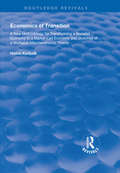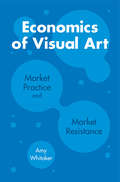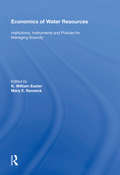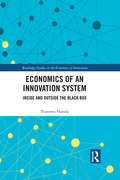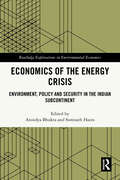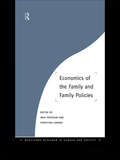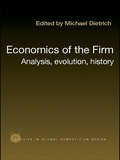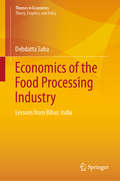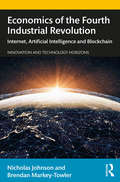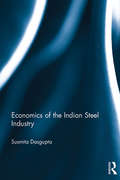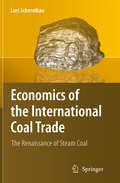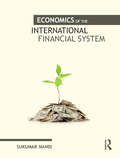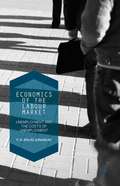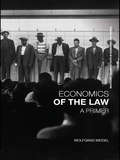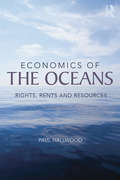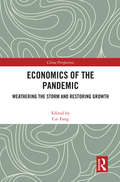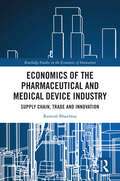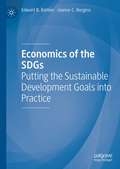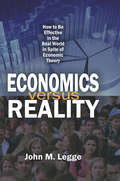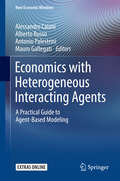- Table View
- List View
Economics of Tourism in Portugal: Impacts of the COVID-19 Pandemic (SpringerBriefs in Economics)
by Vítor João MartinhoThis Brief discusses impacts of the COVID-19 pandemic on the Portuguese tourism sector. Taking into account real-world conditions and the importance of the tourism sector for the Portuguese economy, this book highlights the economic contexts of tourism in Portugal at the regional and municipal levels, discussing pre-pandemic economic frameworks and projecting potential implications for the future. Using data provided by Statistics Portugal, the Brief performs econometric analysis on three cases: new paradigms for overnight stays and guests, changes in tourism revenues and prospective alternatives, and a comparison of effects on changes in number of guests and overnight stays at the regional level. Providing cutting edge analysis of a dynamic global situation, this Brief will be useful for researchers interested in tourism economics and European economics as well as policymakers and industry professionals.
Economics of Transition: A New Methodology for Transforming a Socialist Economy to a Market-led Economy (Routledge Revivals)
by Hüsnü KizilylliFirst published in 1998, this volume responded to the recent fall of the Soviet Union and looks at the process of transitioning away from Socialist economies, including case studies in the former Soviet Union, Poland, Hungary, China, East Germany and other Socialist countries. Taking the view that economic and political indicators suggest a lack of success in the post-Soviet transformation process, Kızılyallı argues that they have been unsuccessful due to poor planning. Kızılyallı notes an abandonment of the previous system and an ineffective implementation of market capitalism which have led to these negative outcomes. The new method developed herein provides a partial solution through estimating the correct exchange rate based on world prices and under conditions of macroeconomic equilibrium, while also allowing planning for sequencing market reforms. Reform issues are then discussed, followed by the reform experiences of Poland, Hungary, East Germany, China and the former Soviet Union. Lastly, developments in macroeconomic theory are reviewed in light of these case studies. Kızılyallı concludes that both neoclassical and new Keynesian theories fail to provide an economically meaningful framework for analysis of current economic and employment problems, nor for their cure.
Economics of Visual Art: Market Practice and Market Resistance
by Amy WhitakerHow can arts managers, artists, and art market observers approach the study of economics? Accompanied by hand-drawn illustrations, wide-ranging case studies, and expansive discussion resources, this interdisciplinary microeconomics primer engages with complex – and, at turns, political – questions of value and resourcefulness with the artist or manager as the decision-maker and the gallery, museum or studio as 'the firm'. Whitaker arms the reader with analytic and creative tools that can be used in service to economic sustainability for artists and organizations. By exploring the complexities of economics in application to art, design and creative industries, this book offers ways to approach the larger world as an art project.
Economics of Water Resources: Institutions, Instruments and Policies for Managing Scarcity (The\international Library Of Environmental Economics And Policy Ser.)
by Mary E. RenwickWater is becoming an increasingly scarce commodity in many parts of the world. Population growth plus a growing appetite for larger quantities of cheap water quality as a result of urban, industrial, and agricultural pollution coupled with increasing environmental demands have further reduced usable suppliers. This book brings together thirty of the best economic articles addressing water scarcity issues within the US and Mexico. By touching on a number of different issues, this volume clearly articulates the need for improving existing institutional arrangements as well as for developing new arrangements to address growing water scarcity problems.
Economics of a Crowded Planet
by Fraser Murison SmithThis book asks the question, how would economics look today and into the future if one started with a blank sheet of paper? Written mainly for a technical audience, yet accessible to the lay reader, Economics of a Crowded Planet addresses the ontology, epistemology and methodology of a future economics as if from outside the economy looking in. It presents a conceptual framework for a future economics drawing from systems science and hierarchy theory, integrating central concepts from present-day economics, so as to orient the field in a direction that can serve society’s future needs in practical ways. The exposition reveals a paradigm called ‘market planetarianism’: the idea that the power of markets may be used to steer the economy toward a desired long-term goal. Both a prescriptive doctrine and an economic methodology, it treats the economy and nature as instances of complex, evolutionary systems, demanding analytical tools quite unlike those of the 20th-century mainstream.
Economics of an Innovation System: Inside and Outside the Black Box (Routledge Studies in the Economics of Innovation)
by Tsutomu HaradaExisting literature looks at national innovation systems from the perspective of either "inside the black box" or "outside the black box". This is the first book that analyzes both the inside and outside of the black box using a general equilibrium framework. The book looks at what is outside the black box and provides models of path-dependent endogenous growth; examines the dynamics of the black box from the intersectoral perspective of the economy; and proposes an innovation flow matrix. It also takes into account both business cycles and endogenous innovation in the unified New Keynesian dynamic stochastic general equilibrium (DSGE) model and examines how business cycles and other policy shocks affect endogenous innovation. The unified treatment of the national innovation system from perspectives both inside and outside the black box using rigorous economic models and empirical analyses makes this an enlightening work, shedding new light on innovation economics.
Economics of the Energy Crisis: Environment, Policy and Security in the Indian Subcontinent (Routledge Explorations in Environmental Economics)
by Somnath Hazra Anindya BhuktaThe global energy crisis is a two-dimensional phenomenon: on the one hand, the gap between a continuously depleting supply capacity of fossil fuel and rapidly increasing demand for energy is fast widening, and, on the other, the burning of fossil fuels intensifies the problem of global warming day by day.This book explores this global crisis through a regional focus, exploring the issues as they relate to the Indian subcontinent. The book argues that since no source of energy is entirely pollution-free, it is essential to place greater emphasis on enhancing energy-use efficiency. This requires proper auditing of existing energy use and proper management of future use. Providing the foundation for this argument, the first section of the book examines the root cause of the problem: the supply-demand imbalance of energy. Alongside this, market imperfections in energy pricing are also discussed. The second section of the volume explores the environmental and political dimensions, examining policies in the region designed to provide a sustainable environment. The third and final sections present several plausible policy prescriptions to solve the problem.This book will be of particular interest to researchers of energy economics and policy, sustainability, environmental studies and South Asia more broadly.
Economics of the Family and Family Policies (Routledge Research In Gender And Society Ser. #Vol. 1)
by Inga Persson Christina JonungEconomic analysis of the family is a recent, but already well established area in economics. This book bears evidence to the lively and relevant research in the area. Essays in this comprehensive collection provide a clear picture of the state of the art of economics of the family and explore theoretical and empirical applications. The contributors
Economics of the Firm: Analysis, Evolution and History (Routledge Studies in Global Competition #Vol. 28)
by Michael DietrichThis book brings together some of the world's leading experts to present an interdisciplinary, critical perspective on current issues surrounding the economics of the firms. It eschews standard approaches to the economics of the firm (including analysis of transaction costs) in favour of a more interdisciplinary outlook, with evolutionary economics taken into account. Central to this is the concept of trust and the belief that any approach to the firm must recognize cultural and political factors. The chapters emphasize the themes of change and evolution and explore issues arising from the history and organization of firms. An important book, with contributions from Bart Nooteboom, Stavros Ioannides and Werner Holzl, this is an invaluable resource for postgraduate students of economics.
Economics of the Food Processing Industry: Lessons from Bihar, India (Themes in Economics)
by Debdatta SahaThis book presents a wealth of perspectives on studying the manufacturing end of food processing industries, with a special focus on regions with a low industrial base and multiple missing markets, institutional finance being the most prominent example. Positioning food processing within the industrial ecosystem, which includes entrepreneurs, policymakers, business consultants and associations, the study first considers three different trajectories: for developed economies, for national territories like India, and for sub-national regions like Bihar. In turn, it shows how these trajectories intertwine in two dimensions: the region and the sub-sector. Successfully completing food-processing projects in any of these trajectories requires the identification and development of appropriate product networks that link basic processed items with advanced ones through a chain of value addition. Moreover, the supply-side narrative presented here identifies two types of costs: physical and non-physical costs of operation. For trajectories with skewed firm sizes (“missing middle”) and missing markets, which can be found in Bihar, the latter costs matter just as much as the former in terms of entrepreneurship. While efficiency in operations is studied for selected sub-sectors in Bihar’s food processing to assess the main sources of inefficiency in minimizing the physical costs of operations, non-physical costs are studied using the construct of region-based counterfactual thinking (rCFT) and its relationship with the perception of risk for entrepreneurs. rCFT offers a new concept for understanding the mindset of the entrepreneur, in which the regional identity plays a significant role. The empirical content is based on a primary survey of food processing in Bihar. Additional policy questions, such as the choice between spatial collocation of food parks or cluster-based development of unique sub-sectors, are explored through an analysis of the policy network that supports entrepreneurship. Issues arising from the government’s policy choices, particularly vertically targeted industrial policies, can influence industrial outcomes and are particularly relevant for regions like Bihar. While policy evaluation for Bihar’s processed food industry yields insights on policy targeting for decision-makers in the government, examples of parallel narratives from global experiences in comparable regions shed new light on industrial development in processed food, which should be of interest to business practitioners, academic researchers and policymakers alike.
Economics of the Fourth Industrial Revolution: Internet, Artificial Intelligence and Blockchain (Innovation and Technology Horizons)
by Nicholas Johnson Brendan Markey-TowlerThis book applies cutting-edge economic analysis and social science to unpack the rich complexities and paradoxes of the Fourth Industrial Revolution. The book takes the reader on a bold, refreshing, and informative tour through its technological drivers, its profound impact on human ecosystems, and its potential for sustainable human development. The overarching message to the reader is that the Fourth Industrial Revolution is not merely something to be feared or survived; rather, this dramatic collision of technologies, disciplines, and ideas presents a magnificent opportunity for a generation of new pioneers to rewrite "accepted rules" and find new avenues to empower billions of people to thrive. This book will help readers to discern the difference between disruption and transformation. The reader will come away from this book with a deeply intuitive and highly contextual understanding of the core technological advances transforming the world as we know it. Beyond this, the reader will clearly appreciate the future impacts on our economies and social structures. Most importantly, the reader will receive an insightful and actionable set of guidelines to assist them in harnessing the Fourth Industrial Revolution so that both they and their communities may flourish. The authors do not primarily seek to make prescriptions for government policy, but rather to speak directly to people about what they can do for themselves, their families, and their communities to be future-proofed and ready to adapt to life in a rapidly evolving world ecosystem.
Economics of the Indian Steel Industry (Routledge Studies in the Economics of Business and Industry)
by Susmita DasguptaSteel is the foundational material of modern civilization and constitutes the core of industry, and yet, it is overproduced across the world. This supply glut is reducing margins and turning steel into a sunset industry. Steel consumes as much as four times the amount of raw materials as its produced volume, and the sheer bulk of the steel makes it costly to transport. Because of this, countries prefer to make their own rather than to source it across land and sea. The Indian steel industry has grown from being the tenth largest steel producer in the world in 1991 to emerging as the second largest, after China. This book aims to reveal, through data and the use of simple economic concepts, the mistakes that abound in the discourses surrounding the steel industry. Its main objective is to dispel the many myths that are perpetuated by policy makers and the industry in order to benefit a small coterie of large firms, and discusses how through such favours the Indian steel industry is set to lose out in terms of margins, products and growth in technology. It covers the unique role of the Indian state in the development of the broad base of steel production, and observes the change in the direction in policy, which reverses the economic equality of the past and promotes collusion among oligopolies leading to overexpansion in capacities. Economics of the Indian Steel Industry will be of interest to students of industrial economics and corporate strategy, as well as financial managers and policy makers.
Economics of the International Coal Trade: The Renaissance of Steam Coal
by Lars SchernikauThe world today depends on oil, coal and gas (in that order of importance) for over 80% of its primary energy. From the time humans tamed fire, wood or bio-mass became the primary energy source. Coal took over from biomass during the Industrial Revolution and accounted for over 60% of world primary energy by the early 1900s. The current age is often referred to as the Oil Age, which seems appropriate now that about 35% of the world's primary energy still comes from oil. However, coal is experiencing a renaissance. Today about one quarter of the world's primary energy and more than 40% of the world's electricity comes from coal. In addition, about two thirds of the world's steel is produced using coal. The author predicts that coal will become even more important in the decades to come, mainly driven by demand from China and India. This book focuses on the role of coal for today's energy and, most importantly, electricity markets. It starts with a review of coal as a resource, profiling the major steam coal exporting nations and the structure of the supply market. The low investment rate in coal compared to other fossil fuels is discussed, and environmental and safety issues with coal production are reviewed. The book examines how coal is used in the modern world. It compares coal to other energy resources and speculates on a greater role for coal in the medium-term future. It examines the structure of the steam coal market, contract terms, derivative markets, FOB costs, and introduces the WorldCoal market model. The final chapter summarizes conclusions and predictions. The author predicts more and larger merger attempts in the coal supply arena and further efforts to manage this development through public policy, greater investment by market participants in logistics and upstream assets, and the development of exchange-based coal trading through standardized coal volumes. The author also outlines why he believes coal prices will rise, eventually catching up with gas.
Economics of the International Financial System
by Sukumar NandiEconomics of the International Financial System offers an illuminating, engaging and lucid account of the working of 21st-century global political economy. From a macroeconomic perspective, it explores how major capitalist economies are closely integrated with each other in that none can remain unaffected by economic events around the globe. The book is one of the first in its genre to examine: the origin and relevance of international money as a concept and phenomenon; the structure of various money markets; the nature and functioning of major international financial institutions such as the World Bank, International Monetary Fund (IMF) and International Bank for Reconstruction and Development (IBRD); and the dynamics of the new world financial system that emerged after the demise of Bretton Woods system. This will form an essential reading for students and scholars of international monetary economics, international corporate finance, researchers, policymakers, bankers and financial executives.
Economics of the Labour Market: Unemployment, Long-term Unemployment And The Costs Of Unemployment
by P. JunankarThe global crisis has led to dramatic increases in unemployment rates over most of the countries of the OECD. This book provides alternative explanations of this phenomenon. Junankar begins with surveys of the labour market: labour demand, labour supply, and labour force participation. He argues that the growth of unemployment and long-term unemployment is mainly due to a lack of aggregated demand and not due to high unemployment benefits. Economics of the Labour Market shows that unemployment and long-term unemployment impose serious and significant costs on individuals, families, and society in general. Raja Junankar focuses on vital social issues arising from the malfunctioning of economies and this collection of essays tackles the real cost of unemployment.
Economics of the Law: A Primer (Routledge Advanced Texts in Economics and Finance)
by Wolfgang WeigelThere is an ever-increasing interest in the question of how and why legal norms can effectively guide human action. This compact volume demonstrates how economic tools can be used to examine this question and scrutinize these legal norms. Indeed, this is one of the first text to be based on civil law instead of the more usual common law, situating the study of both private and public law within the framework of institutional economics, with recommendations for further reading and a list of key terms in each chapter. Besides the standard economic problems in property, tort, contract, crime and litigation, areas covered include: new institutional economics public choice constitutional law public administrations regulatory impact analysis. This book is essential reading for students in law schools and economics departments alike, particularly those engaged with the methodology of law and economics, applied economics and economic methods of legal policy.
Economics of the Oceans: Rights, Rents and Resources
by Paul HallwoodIt is an unfortunate truth that our oceans offer valuable resources that are too often used unsustainably. Time and again this is due to the failure of international law to provide a framework for adequate governance. Economics of the Oceans examines this issue and provides a comprehensive study of ocean uses from the perspectives of law and economics. Themes covered in the book include ocean governance, the economics of oceanic resource exploitation, offshore oil, coral reefs, shipwrecks and maritime piracy. Analytical techniques such as basic game theory, environmental economics of the commons and cost-benefit analysis are employed to illuminate the topics. This book will be of interest to students of environmental economics, natural resource economics and management, and the economics of international law as relating to the oceans.
Economics of the Pandemic: Weathering the Storm and Restoring Growth (China Perspectives)
by Cai FangThe year 2020 marked the time when China expected to attain its goal of building a moderately prosperous society in all respects. Yet it has witnessed the emergence of COVID-19 as a global pandemic that has spread to almost all countries and regions throughout the world. This serious public health disaster has brought with it severe economic shock, resulting in unexpected challenges to the completion of economic and social development goals. This title compiles the latest research, from a variety of perspectives, into the impact of COVID-19 on the Chinese economy. Economic experts and scholars from the Chinese Academy of Social Sciences analyze the current trends as well as short-term and long-term countermeasures in the agricultural, industrial, employment, and public health sectors and focus on supply and demand. They argue that China’s actions toward and promotion of economic recovery need to adapt to variability and uncertainty, and policy choices should be made in the light of the dialectical relationship between variance and invariance. The book will appeal to students and scholars of economics, political science, and social development.
Economics of the Pharmaceutical and Medical Device Industry: Supply Chain, Trade and Innovation (Routledge Studies in the Economics of Innovation)
by Ramesh BhardwajThis book provides a comprehensive examination of the pharmaceutical and medical device industry, including analysis of its current trade and innovation strategies.Opening with a survey of the global pharmaceutical and medical device industry, Bhardwaj outlines the growing trade and trade interdependence among countries in the global supply chain. He adopts a trade competitiveness approach to analyze patterns of product specialization and examines the drug discovery process and its challenges in translating bioscientific knowledge into lifesaving products. Bhardwaj argues that further economic integration, collaborative R&D, and digital technologies may help accelerate productivity and address global challenges of escalating drug costs, neglected tropical diseases (NTDs), and pandemic risks. The book also considers how the industry may further green its supply chain, and thus contribute to SDG Goals 3 (Good Health and Wellbeing) and 12 (Responsible Consumption and Production), before closing on a review of China and India, major players who have the potential to become drivers of low-cost medical products and innovations.With its evidence-based analysis, this book will be of great interest to researchers in pharmaceutical studies, supply chain management, global health, and health economics, as well as policymakers and professionals interested in the global issues facing the industry.
Economics of the SDGs: Putting the Sustainable Development Goals into Practice
by Edward B. Barbier Joanne C. BurgessThis is the first book that employs economics to develop and apply an analytical framework for assessing progress towards the Sustainable Development Goals (SDGs). The authors explore the historical context for the underlying sustainability concept, develop an economics-based analytical framework for assessing progress towards the SDGs, and discuss the implications for sustainability policy and future research. Economics is concerned with analysing the trade-offs in allocating scarce means to achieve various ends. Thus, economic methods are ideally suited to assessing how progress towards one or more SDGs may come at the expense of achieving other goals. Such interactions are inevitable in meeting the 2030 Agenda over the next decade, given that the SDGs include different economic, social, and environmental elements. Although it may be possible to make progress across all 17 goals by 2030, it is more likely that improvement toward all goals will be mixed. For example, we may have reduced poverty or hunger over recent years, but the way in which this progress has been achieved – e.g. through economic expansion and industrial growth – may have come at the cost in achieving some environmental or social goals. On the other hand, progress in reducing poverty is likely to go hand-in-hand with other important goals, such as eliminating hunger, improving clean water and sanitation, and ensuring good health and well-being. Assessing these interactions is essential for guiding policy, so that countries and the international community can begin implementing the right set of environmental, social and economic policies to achieve more sustainable and inclusive global development.
Economics versus Reality: How to be Effective in the Real World in Spite of Economic Theory
by John M LeggeJohn M. Legge shows the many ways in which the real world diverges from economics textbooks. He argues that mainstream economic theory took a disastrous turn 140 years ago, when it attempted to use calculus to explain human behaviour. A real economy involves people who are not variables in equations. This error led to a second, mainstream economics becoming obsessed with equilibrium. However, constant change is the reality and one cannot explain the present without understanding the path taken to get here. This book presents economics in historical context. It includes a short account of the contributions by some of the key figures in economic theory, starting with Adam Smith. Smith placed great weight on morality: he believed that economic activity took place in a society and could not be justified except insofar as it advanced the interests of that society. Too many economists have come to believe that the interests of society can be measured by a number: that if a policy change raises GDP it is justified, whatever its impact on people.Legge places the economy within society, and society within the environment, explaining that every significant decision has a social and environmental impact, as well as an economic dimension. Seeking to provide answers to students, professional business managers, and those interested in the political process, this work addresses the gap between theory and reality.
Economics with Emphasis on the Free Enterprise System
by Joan S. Ryan Irvin B. TuckerNIMAC-sourced textbook
Economics with Heterogeneous Interacting Agents
by Mauro Gallegati Alessandro Caiani Alberto Russo Antonio PalestriniThis book offers a practical guide to Agent Based economic modeling, adopting a learning by doing approach to help the reader master the fundamental tools needed to create and analyze Agent Based models. After providing them with a basic toolkit for Agent Based modeling, it present and discusses didactic models of real financial and economic systems in detail. While stressing the main features and advantages of the bottom-up perspective inherent to this approach, the book also highlights the logic and practical steps that characterize the model building procedure. A detailed description of the underlying codes, developed using R and C, is also provided. In addition, each didactic model is accompanied by exercises and applications designed to promote active learning on the part of the reader. Following the same approach, the book also presents several complementary tools required for the analysis and validation of the models, such as sensitivity experiments, calibration exercises, economic network and statistical distributions analysis. By the end of the book, the reader will have gained a deeper understanding of the Agent Based methodology and be prepared to use the fundamental techniques required to start developing their own economic models. Accordingly, Economics with Heterogeneous Interacting Agents will be of particular interest to graduate and postgraduate students, as well as to academic institutions and lecturers interested in including an overview of the AB approach to economic modeling in their courses. "
Economics without Borders: Economic Research for European Policy Challenges
by Richard Blundell Estelle Cantillon Barbara Chizzolini Marc Ivaldi Wolfgang Leininger Ramon Marimon Laszlo Matyas Frode SteenIf treated as a single economy, the European Union is the largest in the world, with an estimated GDP of over 14 trillion euros. Despite its size, European economic policy has often lagged behind the rest of the world in its ability to generate growth and innovation. Much of the European economic research itself often trails behind that of the USA, which sets much of the agenda in mainstream economics. This book, also available as open access, bridges the gap between economic research and policymaking by presenting overviews of twelve key areas for future economic policy and research. Written for the economists and policymakers working within European institutions, it uses comprehensive surveys by Europe's leading scholars in economics and European policy to demonstrate how economic research can contribute to good policy decisions, and vice versa, demonstrating how economics research can be motivated and made relevant by hot policy questions.
Economics without Preferences: Microeconomics and Policymaking Beyond the Maximizing Individual (Studies in New Economic Thinking)
by Michael MandlerEconomics without Preferences lays out a new microeconomics – a theory of choice behavior, markets, and welfare – for agents who lack the preferences and marginal judgments that economics normally relies on. Agents without preferences defy the rules of the traditional model of rational choice but they can still systematically pursue their interests. The theory that results resolves several puzzles in economics. Status quo bias and other anomalies of behavioral economics shield agents from harm; they are expressions rather than violations of rationality. Parts of economic orthodoxy go out the window. Agents will fail to make the fine-grained trade-offs ingrained in conventional economics, leading market prices to be volatile and cost-benefit analysis to break down. This book provides policy alternatives to fill this void. Governments can spur innovation, the main benefit markets can deliver, while sheltering agents from the upheavals that accompany economic change.

